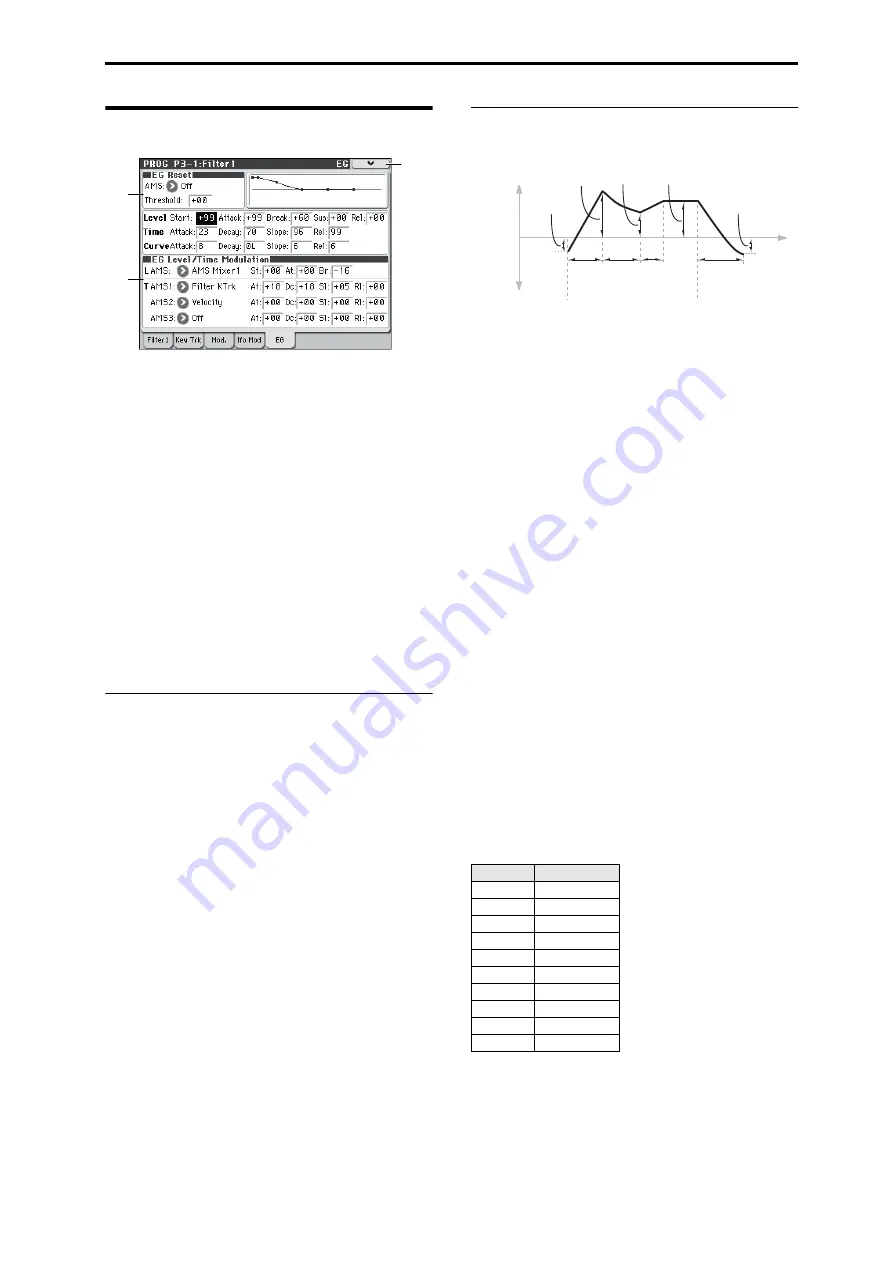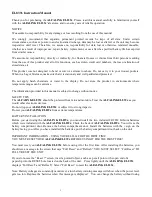
PROG P3–1: Filter1 3–1–5: EG
37
3–1–5: EG
The Filter EG, or Envelope Generator, lets you create
complex, time-varying changes to the cutoff frequencies of
Filters A and B. The parameters on this page control the
shape of the EG. Among other things, you can:
• Create the basic EG shape by setting the levels and times
of each segment.
• Control the curvature of each EG segment, for subtle
control over the modulation shape of the EG.
• Set up complex modulation of EG levels and times.
• Set up an AMS source, such as an LFO, to restart the EG.
To control how much effect the EG has on the filters, use the
Filter EG parameters on the P3–1: Filter1– Modulation page,
as described under “3–1–3a: Filter EG,” on page 34.
Filter EG is also an AMS source
You can use the Filter EG as an AMS source to modulate
other parameters, just like the keyboard tracking and LFOs.
Simply select the Filter EG in the AMS list for the desired
parameter.
3–1–5a: EG Reset
AMS
[List of AMS Sources]
This selects an AMS source to reset the EG to the start point.
For instance, you can use a tempo-synced LFO to trigger the
EG in a repeating rhythm. This reset is in addition to the
initial note-on, which always causes the EG to start.
For a list of AMS sources, please see “AMS (Alternate
Modulation Source) List” on page 374.
Threshold
[–99...+99]
This sets the AMS level which will trigger the EG reset.
Among other things, you can use this to adjust the exact
point in an LFO’s phase at which the EG will be reset,
effectively controlling its “groove” against other rhythmic
effects.
When the threshold is
positive
, the EG triggers when
passing through the threshold moving upwards. When the
threshold is
negative
, the EG triggers when passing through
the threshold moving downwards.
Note:
With some LFO shapes, and with faster LFO speeds,
the LFO may not always reach the extreme values of +99 or
–99. In this case, setting the
Threshold
to these values may
cause inconsistent behavior, or may mean that the EG
doesn’t reset at all. If this happens, reduce the
Threshold
until the EG triggers consistently.
3–1–5b: Envelope
Filter EG
An envelope creates a modulation signal by moving from
one level to another over a specified time, and then moving
to another level over another period of time, and so on.
The parameters below let you set five levels, the amount of
time it takes to go from each of the levels to the next, and the
shape (from linear to curved) of each transition.
Level
Each of the five levels can be either positive or negative.
Positive
levels will make the cutoff frequency (or other AMS
destination) go up from its programmed value;
negative
levels will make it go down.
Start
[–99...+99]
This sets the initial EG level at note-on.
Attack
[–99...+99]
This sets the level at the end of the Attack time.
Break
[–99...+99]
Break, short for Break Point, sets the level at the end of the
Decay time.
Sus (Sustain)
[–99...+99]
This sets the level at the end of the Slope time. Once it
reaches the Sustain level, the EG will stay there until note-
off, unless it is reset via AMS.
Rel (Release)
[–99...+99]
This sets the level at the end of the Release time.
Time
Higher values mean longer times, as shown below:
Attack
[00...99]
This sets how long the EG takes to move from the Start level
to the Attack level.
For the fastest possible attack time, you can set the Start
level to +99; in this case, the EG will start instantaneously at
its maximum value.
3–1
–5a
3–1
–5b
3–1
–5
Menu
EG Value
Actual Time
10
10 ms
20
44 ms
30
104 ms
40
224 ms
50
464 ms
60
944 ms
70
1.8 seconds
80
3.8 seconds
90
10.9 seconds
99
87.3 seconds
Note-on or reset
Note-off
Attack
Time
Star t
Level
Decay
Time
Release
Time
Release
Level
Attack
Level
Change to
filter cutoff
Sustain
Level
Time
Break
Level
Slope
Time
Summary of Contents for M50-73
Page 1: ...2 E Parameter Guide ...
Page 86: ...Program mode 78 ...
Page 132: ...Combination mode 124 ...
Page 222: ...Sequencer mode 214 ...
Page 297: ...Effect Mixer Block Diagrams Main Outputs 289 ...
Page 418: ...Appendices 410 ...
















































